Nitrogen Split Application Can Improve the Stalk Lodging Resistance of Maize Planted at High Density
Abstract
1. Introduction
2. Materials and Methods
2.1. Experimental Station
2.2. Experimental Design
2.3. Measurements and Methods
2.3.1. Stalk Breaking Force
2.3.2. Mechanical Strength of Basal Internodes
2.3.3. Carbohydrate and Total Nitrogen Contents of Basal Internodes
2.4. Data Analysis
3. Results
3.1. Stalk Breaking Force
3.2. Stalk Mechanical Strength
3.3. DWUL and Carbohydrate Content of Basal Internodes
3.4. N Content of the Basal Internode
3.5. Related Analysis
4. Discussion
5. Conclusions
Author Contributions
Funding
Conflicts of Interest
References
- Flint-Garcia, S.A.; Jampatong, C.; Darrah, L.L.; McMullen, M.D. Quantitative trait locus analysis of stalk strength in four maize populations. Crop Sci. 2003, 43, 13–23. [Google Scholar] [CrossRef]
- Bian, D.; Jia, G.; Cai, L.; Ma, Z.; Cui, Y. Effects of tillage practices on root characteristics and root lodging resistance of maize. Field Crops Res. 2015, 185, 89–96. [Google Scholar] [CrossRef]
- Ma, D.; Xie, R.; Liu, X.; Niu, X.; Hou, P.; Wang, K.; Lu, Y.; Li, S. Lodging-Related stalk characteristics of maize varieties in China since the 1950s. Crop Sci. 2014, 54, 2805–2814. [Google Scholar] [CrossRef]
- Pellerin, S.; Trendel, R.; Duparque, A. Relationship between morphological characteristics and lodging susceptibility of maize (Zea mays L.). Agronomie 1990, 10, 439–446. [Google Scholar] [CrossRef]
- Kamara, A.Y.; Kling, J.G.; Menkir, A.; Ibikunle, O. Association of vertical root-pulling resistance with root lodging and grain yield in selected S-1 maize lines derived from a tropical low-nitrogen population. J. Agron. Crop Sci. 2003, 189, 129–135. [Google Scholar] [CrossRef]
- Li, S.Y.; Wei, M.A.; Peng, J.Y.; Chen, Z.M. Study on yield loss of summer maize due to lodging at the big flare stage and grain filling stage. Sci. Agric. Sin. 2015, 48, 3952–3964. [Google Scholar]
- Xue, J.; Xie, R.Z.; Zhang, W.F.; Wang, K.R.; Peng, H.; Bo, M.; Ling, G.; Shao-Kun, L.I. Research progress on reduced lodging of high-yield and-density maize. J. Integr. Agric. 2017, 16, 2717–2725. [Google Scholar] [CrossRef]
- Brune, P.F.; Baumgarten, A.; McKay, S.J.; Technow, F.; Podhiny, J.J. A biomechanical model for maize root lodging. Plant Soil 2018, 422, 397–408. [Google Scholar] [CrossRef]
- Wu, H.Y.; Zhang, Y.J.; Zhang, W.F.; Wang, K.R.; Jiang, C.D. Photosynthetic characteristics of senescent leaf induced by high planting density of maize at heading stage in the field. Acta Agron. Sin. 2019, 45, 248–255. [Google Scholar] [CrossRef]
- Xue, J.; Gou, L.; Zhao, Y.; Yao, M.; Yao, H.; Tian, J.; Zhang, W. Effects of light intensity within the canopy on maize lodging. Field Crops Res. 2016, 188, 133–141. [Google Scholar] [CrossRef]
- Remison, S.U.; Akinleye, D. Relationship between lodging, morphological characters and yield of varieties of maize (Zea mays L.). J. Agric. Sci. 1978, 91, 633–638. [Google Scholar] [CrossRef]
- Esechie, H.A. Relationship of stalk morphology and chemical composition to lodging resistance in maize (Zea mays L.) in a rainforest zone. J. Agric. Sci. 1985, 104, 429–433. [Google Scholar] [CrossRef]
- Abedon, B.G.; Darrah, L.L.; Tracy, W.F. Developmental changes associated with divergent selection for rind penetrometer resistance in the MoSCSSS maize synthetic. Crop Sci. 1999, 39, 108–114. [Google Scholar] [CrossRef]
- Peiffer, J.A.; Flint-Garcia, S.A.; Leon, N.D.; Mcmullen, M.D.; Kaeppler, S.M.; Buckler, E.S. The genetic architecture of maize stalk strength. PLoS ONE 2013, 8, e67066. [Google Scholar] [CrossRef]
- Bosch, M.; Mayer, C.D.; Cookson, A.; Donnison, I.S. Identification of genes involved in cell wall biogenesis in grasses by differential gene expression profiling of elongating and non-elongating maize internodes. J. Exp. Bot. 2011, 62, 3545–3561. [Google Scholar] [CrossRef]
- Xue, J.; Gao, S.; Fan, Y.; Li, L.; Ming, B.; Wang, K.; Xie, R.; Hou, P.; Li, S. Traits of plant morphology, stalk mechanical strength, and biomass accumulation in the selection of lodging-resistant maize cultivars. Eur. J. Agron. 2020, 117, 126073. [Google Scholar] [CrossRef]
- Xu, C.; Gao, Y.; Tian, B.; Ren, J.; Meng, Q.; Pu, W. Effects of EDAH, a novel plant growth regulator, on mechanical strength, stalk vascular bundles and grain yield of summer maize at high densities. Field Crops Res. 2017, 200, 71–79. [Google Scholar] [CrossRef]
- Zhang, J.; Li, G.H.; Song, Y.P.; Liu, Z.H.; Yang, C.D.; Tang, S.; Zheng, C.Y.; Wang, S.H.; Ding, Y.F. Lodging resistance characteristics of high-yielding rice populations. Field Crops Res. 2014, 161, 64–74. [Google Scholar] [CrossRef]
- Robertson, D.J.; Julias, M.; Lee, S.Y.; Cook, D.D. Maize stalk lodging: Morphological determinants of stalk strength. Crop Sci. 2017, 57, 926–934. [Google Scholar] [CrossRef]
- Zhang, Y.; Liu, P.; Zhang, X.; Zheng, Q.; Chen, M.; Ge, F.; Li, Z.; Sun, W.; Guan, Z.; Liang, T. Multi-Locus genome-wide association study reveals the genetic architecture of stalk lodging resistance-related traits in maize. Front. Plant Sci. 2019, 9, 611. [Google Scholar] [CrossRef]
- Chen, Y.; Chen, J.; Zhang, Y.; Zhou, D. Effect of harvest date on shearing force of maize stems. Livest. Sci. 2007, 111, 33–44. [Google Scholar] [CrossRef]
- Hebert, Y.; Guingo, E.; Loudet, O. The response of root/shoot partitioning and root morphology to light reduction in maize genotypes. Crop Sci. 2001, 41, 363–371. [Google Scholar] [CrossRef]
- Ma, D.L.; Xie, R.Z.; Niu, X.K.; Li, S.K.; Long, H.L.; Liu, Y.E. Changes in the morphological traits of maize genotypes in China between the 1950s and 2000s. Eur. J. Agron. 2014, 58, 1–10. [Google Scholar] [CrossRef]
- Shi, D.Y.; Li, Y.H.; Zhang, J.W.; Liu, P.; Zhao, B.; Dong, S.T. Effects of plant density and nitrogen rate on lodging-related stalk traits of summer maize. Plant Soil Environ. 2016, 62, 299–306. [Google Scholar]
- Rajkumara, R. Lodging in cereals-a review. Agric. Rev. 2008, 29, 55–60. [Google Scholar]
- Li, H.C.; Li, L.A.; Wegenast, T.; Longin, C.F.; Xu, X.W.; Melchinger, A.E.; Chen, S.J. Effect of N supply on stalk quality in maize hybrids. Field Crops Res. 2010, 118, 208–214. [Google Scholar] [CrossRef]
- Chilundo, M.; Joel, A.; Wesstrom, I.; Brito, R.; Messing, I. Response of maize root growth to irrigation and nitrogen management strategies in semi-arid loamy sandy soil. Field Crops Res. 2017, 200, 143–162. [Google Scholar] [CrossRef]
- Zartash, F.; Qaiser, A.; Amna, K.; Sajjad, H.; Muhammad, A.; Ghulam, A.; Haseeb, Y.; Shahrish, N.; Muhammad, I.; Muhammad, S. Resource use efficiencies of C3 and C4 cereals under split nitrogen regimes. Agron. J. 2018, 8, 1–16. [Google Scholar]
- Zhang, G.Q.; Shen, D.P.; Xie, R.Z.; Ming, B.; Xue, J.; Li, R.F.; Chen, J.L.; Wang, K.R.; Li, S.K. Optimizing planting density to improve nitrogen use of super high-yield maize. Agron. J. 2020, 1–12. [Google Scholar] [CrossRef]
- Page, A.L.; Miller, R.H.; Keeney, D.R. Methods of soil analysis, part 2: Chemical and microbiological properties. In American Society of Agronomy and Soil Science Society of America, 2nd ed.; Wisconsin: Madison, WI, USA, 1982; pp. 885–891. [Google Scholar]
- Olsen, S.R.; Cole, C.V.; Watanabe, F.S. Estimation of Available Phosphorus in Soils by Extraction with Sodium Bicarbonate; US Department of Agriculture: Washington, DC, USA, 1954; Volume 939, p. 19.
- Cox, A.E.; Joern, B.C.; Brouder, S.M.; Gao, D. Plant-available potassium assessment with a modified sodium tetraphenylboron method. Soil Sci. Soc. Am. J. 1999, 63, 902–911. [Google Scholar] [CrossRef]
- Lu, R.K. Analysis of Soil Agrochemicals; China Agricultural Science and Technology Press: Beijing, China, 2000; pp. 106–107. [Google Scholar]
- Zhang, G.Q.; Liu, C.W.; Xiao, C.H.; Xie, R.Z.; Ming, B.; Hou, P.; Liu, G.Z.; Xu, W.J.; Shen, D.P.; Wang, K.R.; et al. Optimizing water use efficiency and economic return of super high yield spring maize under drip irrigation and plastic mulching in arid areas of China. Field Crop Res. 2017, 211, 137–146. [Google Scholar] [CrossRef]
- Robertson, D.; Smith, S.; Gardunia, B.; Cook, D. An improved method for accurate phenotyping of corn stalk strength. Crop Sci. 2014, 54, 2038–2044. [Google Scholar] [CrossRef]
- Zheng, X.G.; Xin, R.Z. Determination of nitrogen content of fertilizer by automatic Kjeldahl apparatus. Chem. Anal. Meterage 2014, 23, 41–43. [Google Scholar]
- Zhou, D.W.; Chen, J.; She, J.K.; Tong, J.; Chen, Y.X. Temporal dynamics of shearing force of rice stem. Biomass Bioenergy 2012, 47, 109–114. [Google Scholar] [CrossRef]
- Muchow, R.C.; Sinclair, T.R. Nitrogen response of leaf photosynthesis and canopy radiation use efficiency in field-grown maize and sorghum. Crop Sci. 1994, 34, 721–727. [Google Scholar] [CrossRef]
- Kim, S.H.; Sicher, R.C.; Bae, H.; Gitz, D.C.; Reddy, V.R. Canopy photosynthesis, evapotranspiration, leaf nitrogen, and transcription profiles of maize in response to CO2 enrichment. Glob. Chang. Biol. 2006, 12, 588–600. [Google Scholar] [CrossRef]
- Liu, Y.; Hou, P.; Xie, R.; Li, S.; Zhang, H.; Ming, B.; Ma, D.; Liang, S. Spatial adaptabilities of spring maize to variation of climatic conditions. Crop Sci. 2013, 53, 1693–1703. [Google Scholar] [CrossRef]
- Beck, D.L.; Darrah, L.L.; Zuber, M.S. Effect of sink level on root and stalk quality in maize. Crop Sci. 1988, 28, 11–18. [Google Scholar] [CrossRef]
- Xue, J.; Zhao, Y.; Gou, L.; Shi, Z.; Yao, M.; Zhang, W. How high plant density of maize affects basal internode development and strength formation. Crop Sci. 2016, 56, 3295–3306. [Google Scholar] [CrossRef]
- Wang, S.; Han, X.R.; Zhan, X.M.; Yang, J.F.; Wang, Y.; Liu, Y.F.; Li, N. Effect of nitrogenous fertilizer levels on photosynthetic functions of maize ear leaves at grain filling stage. J. Plant Nutr. Fertitizer 2014, 20, 280–289. [Google Scholar]
- Li, Q.; Ma, X.J.; Cheng, Q.B.; Dou, P.; Yu, D.H.; Luo, Y.H.; Yuan, J.C.; Kong, F.L. Effects of nitrogen fertilizer on post-silking dry matter production and leaves function characteristics of low-nitrogen tolerance maize. Chin. J. Eco-Agric. 2016, 24, 17–26. [Google Scholar]
- Bian, D.H.; Liu, M.X.; Niu, H.F.; Wei, Z.B.; Xiong, D.U.; Cui, Y.H. Effects of nitrogen application times on stem traits and lodging of summer maize (Zea mays L.) in the Huang-Huai-Hai plain. Sci. Agric. Sin. 2017, 50, 2294–2304. [Google Scholar]
- Liu, M.; Qi, H.; Zhang, W.J.; Zhang, Z.P.; Li, X.F.; Song, Z.W.; Yu, J.L.; Wu, Y.N. Effects of deep loosening and nitrogen application on anatomical structures of stalk and lodging in maize. J. Maize Sci. 2013, 21, 57–63. [Google Scholar]
- Appenzeller, L.; Doblin, M.; Barreiro, R.; Wang, H.; Niu, X.; Kollipara, K.; Carrigan, L.; Tomes, D.; Chapman, M.; Dhugga, K.S. Cellulose synthesis in maize: Isolation and expression analysis of the cellulose synthase (CesA) gene family. Cellulose 2004, 11, 287–299. [Google Scholar] [CrossRef]
- Wang, T.J.; Zhang, L.; Han, Q.; Zheng, F.X.; Wang, T.Q.; Feng, N.N.; Wang, T.X. Effects of stalk cell wall and tissue on the compressive strength of maize. Plant Sci. J. 2015, 38, 505–511. [Google Scholar]
- Ma, F.Q.; Liu, X.G.; Wang, H.W.; Huang, C.L.; Wu, Y.J.; Hu, X.J.; Liu, Z.F. Stalk fiber quality traits and their correlations in maize. Crops 2014, 4, 44–48. [Google Scholar]
- Feng, G.; Huang, C.L.; Xing, J.F. The research progress in lodging resistance of maize. Crops 2008, 4, 12–14. [Google Scholar]
- Wang, Y.L.; Li, C.H.; Tan, J.F.; Zhang, X.; Liu, T.X. Effect of postponing N application on yield, nitrogen absorption and utilization in super-high-yield summer maize. Acta Agron. Sin. 2011, 37, 339–347. [Google Scholar] [CrossRef]
- Gao, W.; Yang, J.; Ren, S.; Liu, H. The trend of soil organic carbon, total nitrogen, and wheat and maize productivity under different long-term fertilizations in the upland fluvo-aquic soil of North China. Nutr. Cycl. Agroecosyst. 2015, 103, 61–73. [Google Scholar] [CrossRef]
- Guo, J.; Liu, X.; Zhang, Y.; Shen, J.; Han, X.; Zhang, W.; Christie, P.; Goulding, K.; Vitousek, P.M.; Zhang, F.S.; et al. Significant acidification in major Chinese croplands. Science 2010, 327, 1008–1010. [Google Scholar] [CrossRef]
- Diaz, R.; Rosenberg, R. Spreading dead zones and consequences for marine ecosystems. Science 2008, 321, 926–929. [Google Scholar] [CrossRef] [PubMed]
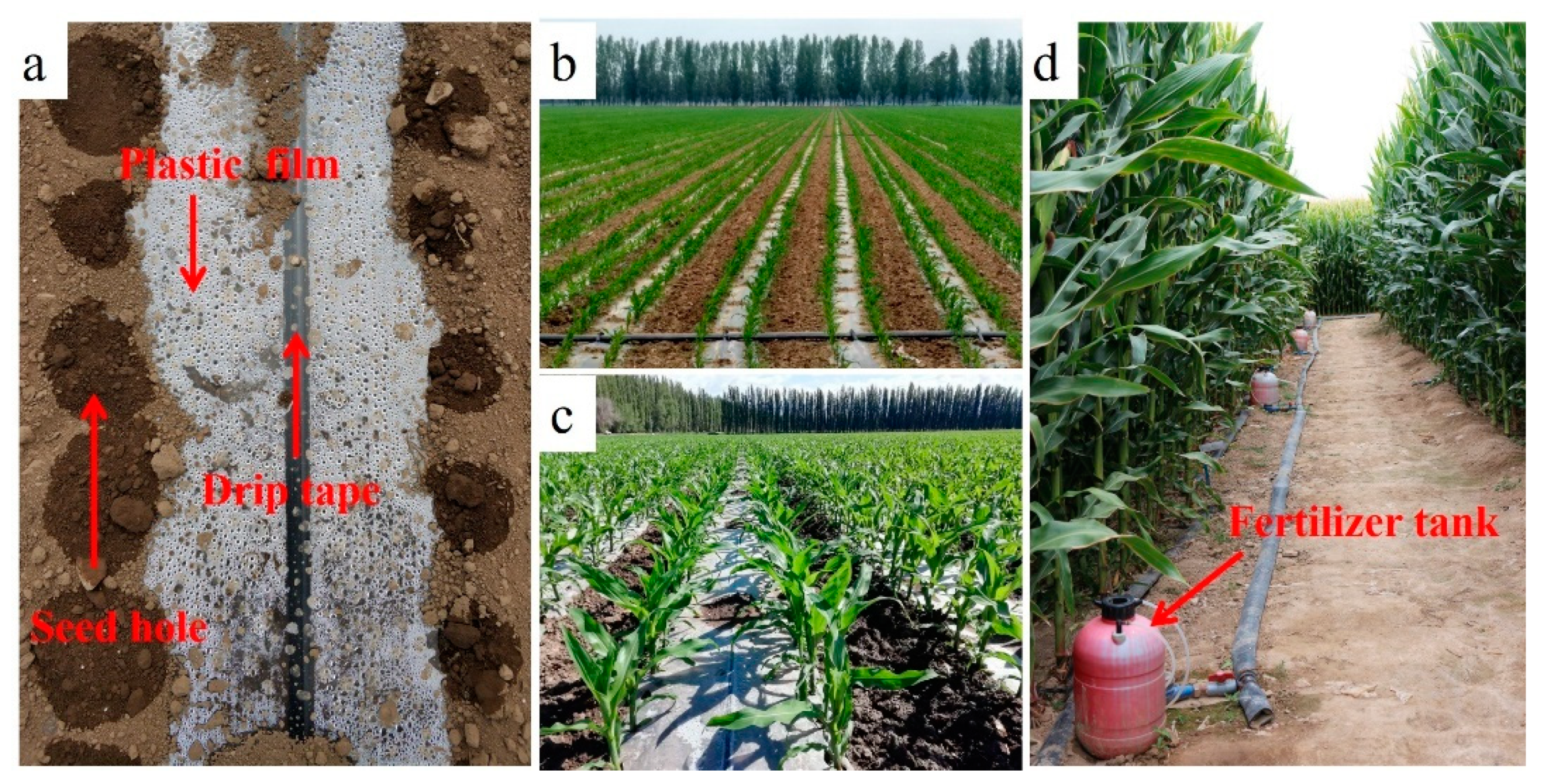

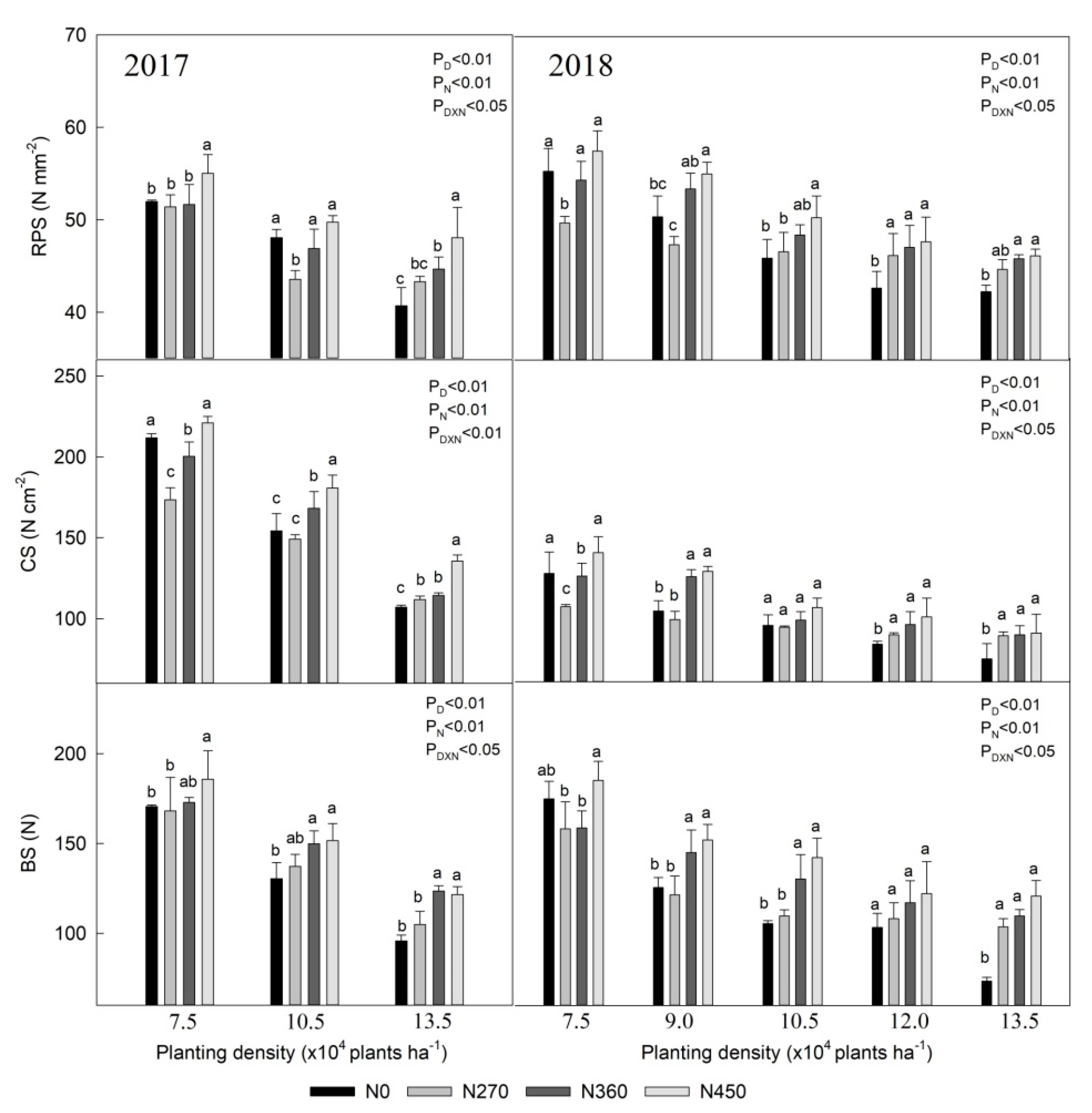
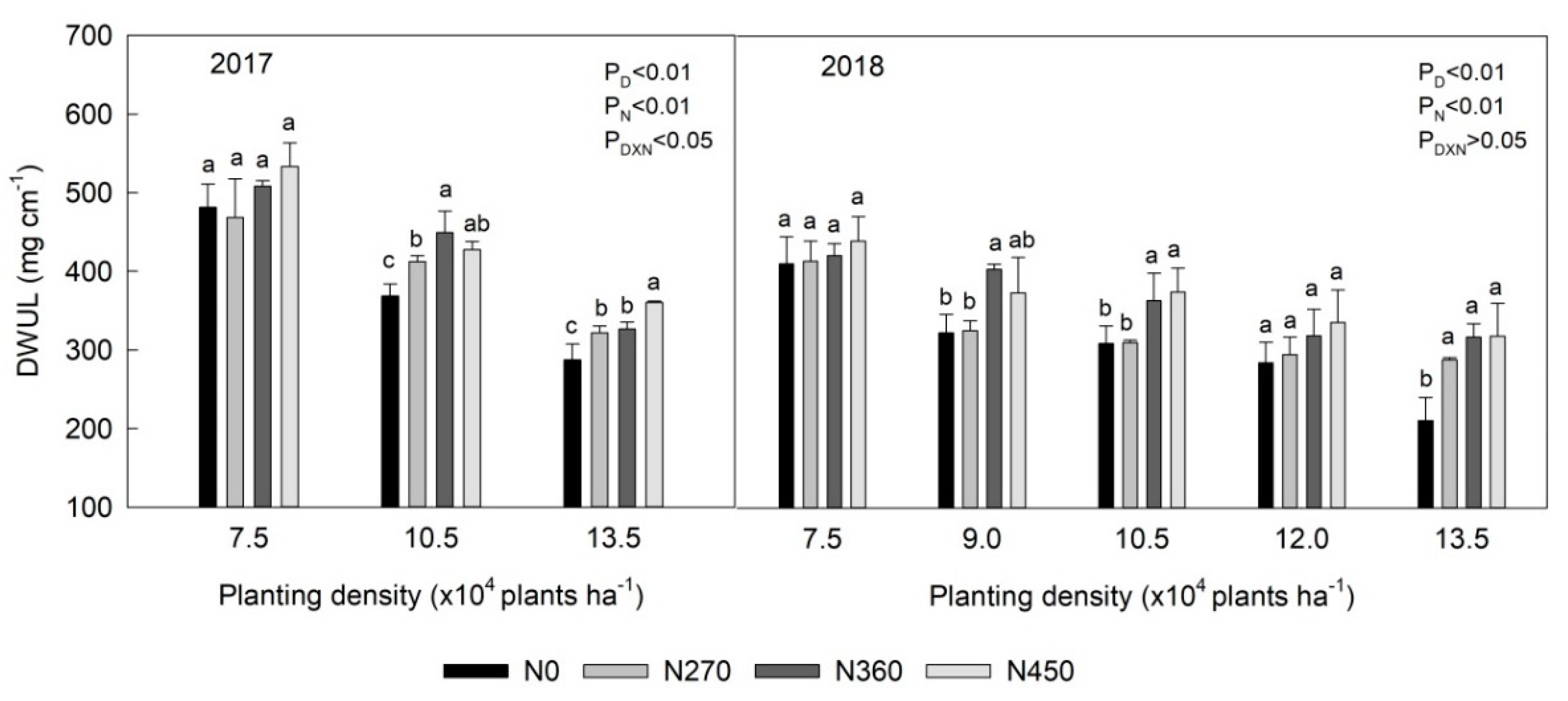
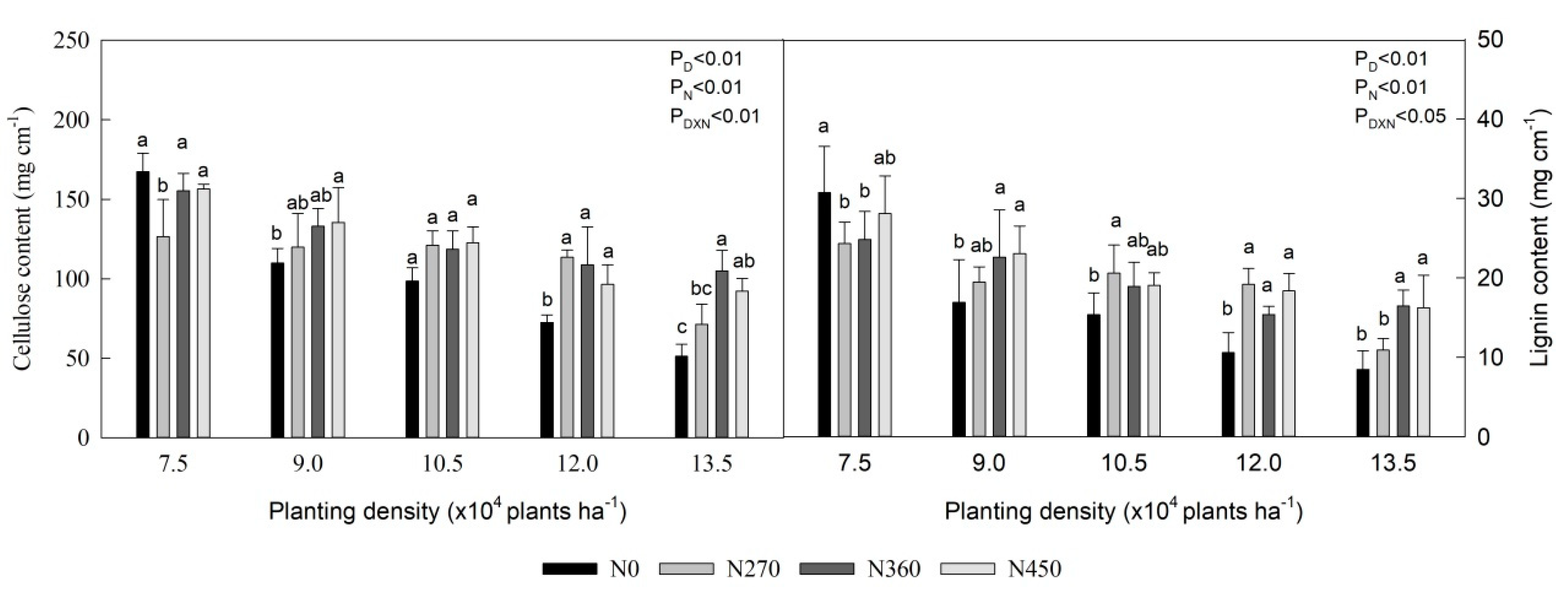
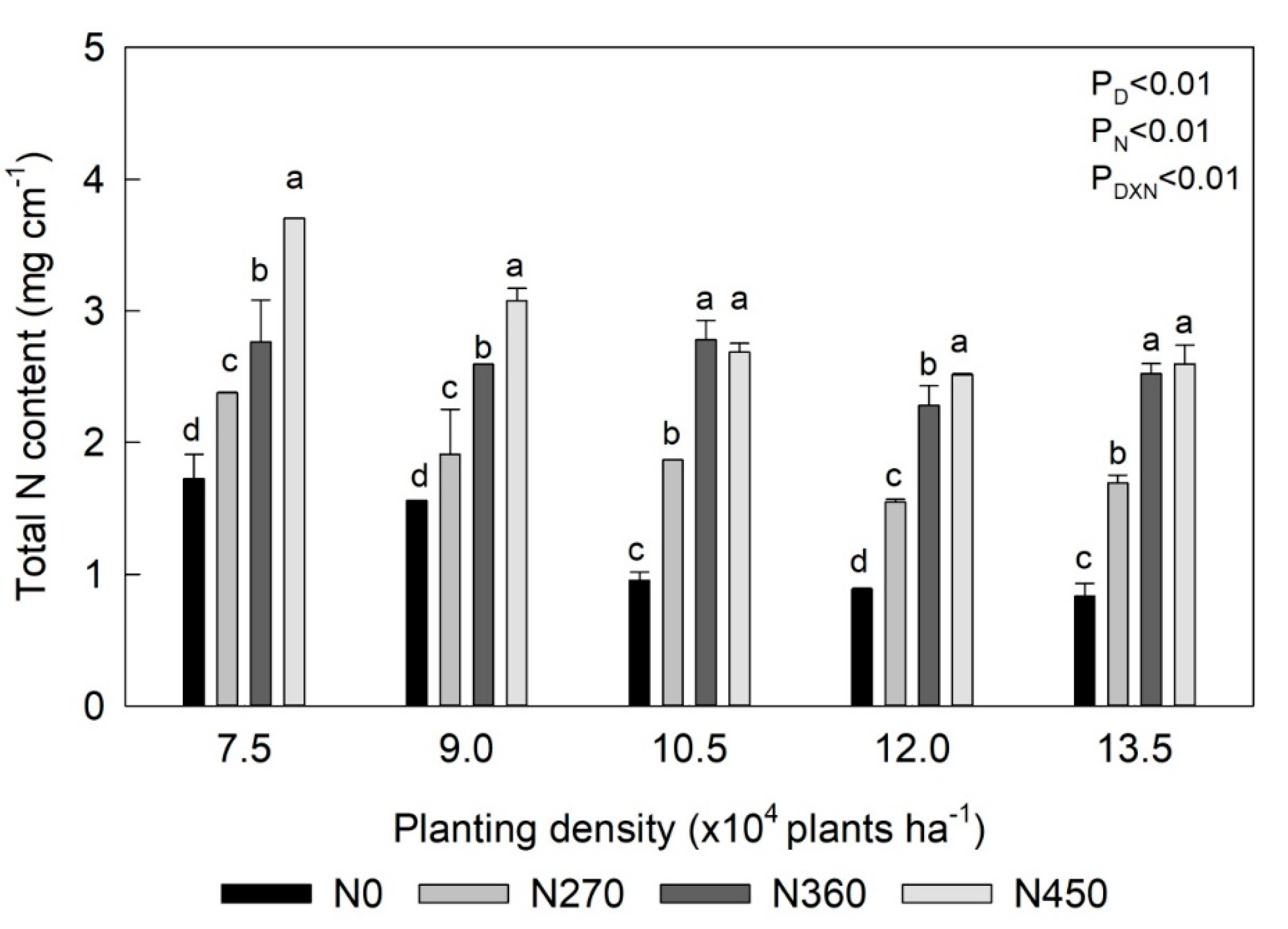

| Month | Precipitation (mm) | Average Temperature (°C) | Maximum Temperature (°C) | Minimum Temperature (°C) | ||||||||
|---|---|---|---|---|---|---|---|---|---|---|---|---|
| 2017 | 2018 | 2007–2016 Average | 2017 | 2018 | 2007–2016 Average | 2017 | 2018 | 2007–2016 Average | 2017 | 2018 | 2007–2016 Average | |
| May | 42.7 | 59.5 | 26.7 | 17.2 | 13.7 | 17.0 | 23.6 | 21.0 | 24.9 | 10.7 | 6.5 | 9.3 |
| June | 72.2 | 6.2 | 25.0 | 21.0 | 20.9 | 21.8 | 27.3 | 27.7 | 29.3 | 14.9 | 13.9 | 14.2 |
| July | 0.9 | 15.9 | 35.5 | 24.3 | 21.9 | 23.2 | 30.7 | 28.4 | 31.1 | 17.9 | 15.2 | 15.5 |
| August | 18.9 | 88.0 | 28.5 | 20.5 | 21.1 | 21.7 | 27.1 | 27.8 | 30.4 | 14.4 | 14.8 | 13.9 |
| September | 13.5 | 30.9 | 17.8 | 14.9 | 12.7 | 15.5 | 22.4 | 20.6 | 24.6 | 8.1 | 5.9 | 8.1 |
| October | 27.8 | 28.1 | 15.7 | 5.2 | 6.4 | 7.8 | 12.6 | 13.9 | 16.4 | −0.7 | 0.5 | 1.9 |
| Total/average | 176.0 | 228.6 | 137.3 | 17.2 | 16.1 | 17.8 | 24.0 | 23.2 | 26.1 | 10.9 | 9.5 | 10.5 |
| Year | Alkali-Hydrolyzed Nitrogen (mg kg−1) | Available Phosphorus (mg kg−1) | Available Potassium (mg kg−1) | Organic Matter (g kg−1) | pH |
|---|---|---|---|---|---|
| 2017 | 81.5 | 65.9 | 147.3 | 14.3 | 8.0 |
| 2018 | 73.4 | 59.1 | 93.8 | 11.8 | 7.9 |
| Breaking Force | DWUL | RPS | CS | |
|---|---|---|---|---|
| DWUL | 0.896 ** | |||
| RPS | 0.668 ** | 0.713 ** | ||
| CS | 0.884 ** | 0.899 ** | 0.510 ** | |
| BS | 0.851 ** | 0.940 ** | 0.864 ** | 0.768 ** |
© 2020 by the authors. Licensee MDPI, Basel, Switzerland. This article is an open access article distributed under the terms and conditions of the Creative Commons Attribution (CC BY) license (http://creativecommons.org/licenses/by/4.0/).
Share and Cite
Wang, Q.; Xue, J.; Zhang, G.; Chen, J.; Xie, R.; Ming, B.; Hou, P.; Wang, K.; Li, S. Nitrogen Split Application Can Improve the Stalk Lodging Resistance of Maize Planted at High Density. Agriculture 2020, 10, 364. https://doi.org/10.3390/agriculture10080364
Wang Q, Xue J, Zhang G, Chen J, Xie R, Ming B, Hou P, Wang K, Li S. Nitrogen Split Application Can Improve the Stalk Lodging Resistance of Maize Planted at High Density. Agriculture. 2020; 10(8):364. https://doi.org/10.3390/agriculture10080364
Chicago/Turabian StyleWang, Qun, Jun Xue, Guoqiang Zhang, Jianglu Chen, Ruizhi Xie, Bo Ming, Peng Hou, Keru Wang, and Shaokun Li. 2020. "Nitrogen Split Application Can Improve the Stalk Lodging Resistance of Maize Planted at High Density" Agriculture 10, no. 8: 364. https://doi.org/10.3390/agriculture10080364
APA StyleWang, Q., Xue, J., Zhang, G., Chen, J., Xie, R., Ming, B., Hou, P., Wang, K., & Li, S. (2020). Nitrogen Split Application Can Improve the Stalk Lodging Resistance of Maize Planted at High Density. Agriculture, 10(8), 364. https://doi.org/10.3390/agriculture10080364









